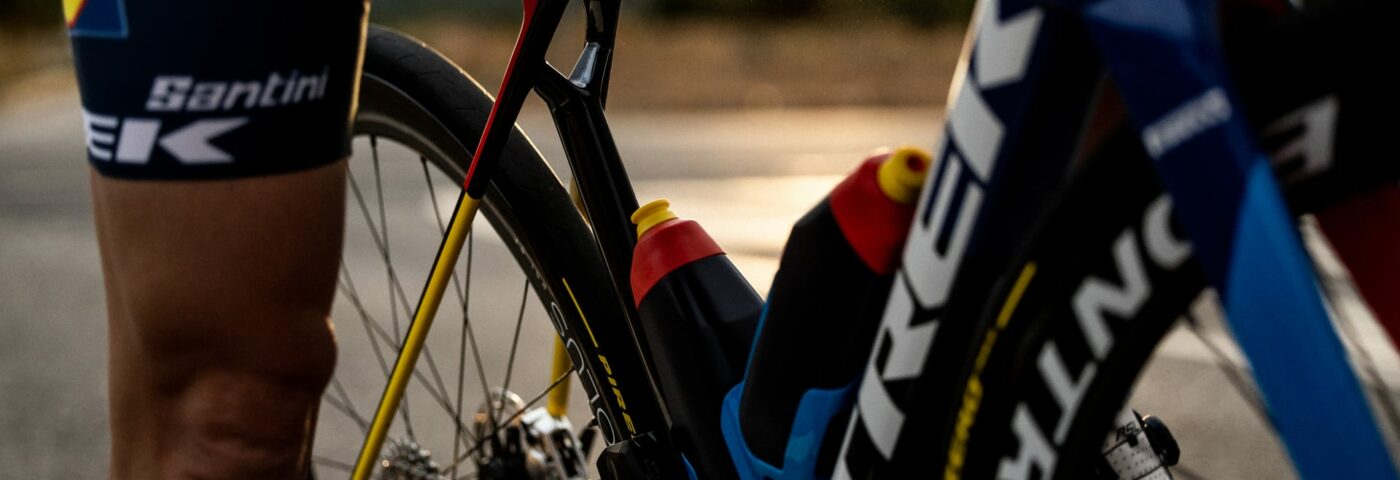Bike bottles may appear as insignificant pieces of equipment, yet their influence on the bike’s overall performance can be surprising. In this article, we cover what to look for when shopping for a bottle, how bike bottles affect cycling aerodynamics and what to do about it, and, finally, share some tricks on using bike bottles most effectively in a race scenario.
What to look for in a bike bottle for road cycling
Many riders overlook the significance of a bike bottle, considering it a basic piece of equipment. While many individuals opt for free, used bottles, intentionally selecting one might be worthwhile.
- Aerodynamics: Readers of our trilogy on aerodynamics know that round shapes are poison for good aero performance. Typical bottles and cages are round, and even if modern bikes can be assumed to be designed with water bottles in mind, it’s almost always a penalty and likely not using bottles is the fastest (see below). Then again, being dehydrated is a sure way to lose even more than a couple of watts…
- Weight: A little lighter does never hurt, especially if it doesn’t come at a much-increased cost.
- Liquid flow: How fast and easily water comes out of the bottle may be important for some scenarios, especially in high-speed events such as criteriums or cyclocross, where there is little time to take a sip.
- Color: It all boils down to personal preference, but it’s worth noting that light-colored bottles clearly show dirt, impurities, and mold, especially if a sugary energy drink is left inside for too long (ugh!). These things may not be as visible on a black bottle. Further, it has been suggested that light-colored bottles take a bit longer to heat up in the sun. Additionally, Clear bottles allow you to see the liquid level, but the yellowish color of some performance drinks may not be the most appealing.
- Size: Standard sizes range from about 500 mL to almost 1000 mL. The ideal size depends on the type of event and how often you can refill. See some tips about races below.
- Grip: Bottles falling out the cages are a nuisance while general riding, a big danger in the peloton and can become really painful in a bike race if you can’t refuel for a while. To ensure the best compatibility, it may be advisable to choose a bottle cage that matches the brand of the bottle.
- Insulation: Some manufacturers claim improved insulation capabilities. Beyond special insulated vacuum bottles for hot tea and winter riding, the simple wrapping of some insulation material adds weight and volume. Yet, just has a minimal effect (s. test in the video below).
- Valve type: There are two main types of mechanisms used for dispensing liquids: the “push/pull” method, where the valve must be manually opened or closed, and the squeeze membrane method, where the valve opens when pressure is applied to the bottle. While the squeeze membrane method may seem more convenient, it requires more force to dispense the liquid and is often more challenging to clean, as many riders have found.
Test results of the most common bike bottles show a clear winner
Tobias from the Rides of Japan YouTube channel released an entertaining video in which he thoroughly tested the most common bike bottles. While he doesn’t declare a winner, we do: The Elite Fly bottle. It is by far the lightest, offers the fastest liquid flow and, combined with Elite’s own premium bottle cages, it seems to be one of the best classic setups available nowadays.
However, the latest innovation in this space includes aerodynamically optimized bottles and cages, which are also usable for general riding and road racing and are not limited to time-trialing. We will discover them in the next chapter below. For now, watch the full video; it’s an entertaining watch.
Three squeeze-valve-type bottles, Polar Breakaway Insulated, TacX Shanti 500, and Camelpak Podium Chill Insulated 21 oz, and three with a push-pull mechanism, Elity Fly Tex 750 mL, TacX Shiva 750 and Specialist Purist MoFlo 22 oz, were in the test. In addition to the video, there is also a Google Sheet if you like to dive into the details.
The Elite Fly bottle is 30% lighter and provides a 70% faster liquid flow compared to most competitors. When paired with the right bottle cage, it creates an exceptional combination that is widely used by the pro peloton.
The Elite Fly Tex is significantly lighter than its closest competitor, the TacX Shiva, weighing only 70% as much. It has a liquid flow rate over 50% higher than its competitors and is the easiest to squeeze. However, it should be noted that it may not fit as securely in some bottle cages (Elite bottle cage was not tested).
Consider the robustness, insulation and environmental impact of a bike bottle
The downside of the Elite Fly bottle is its lack of robustness due to its lightweight construction. Using a more robust bottle for general training rides or maybe even longer bike-packing or ultra-endurance events may be advisable. Many other options are available, but one classic example is the Tacx Shiva bottle. This bottle is often given away for free with custom printing.
Some bottles also offer a protection cap, which is especially useful when riding through dirt, even though it makes drinking and handling a little more tricky. As such, the Elite Fly also offers an MTB version with a simple, removable plastic cap.
Another offering is bottles with thermal insulation wrappers, but they only add bulk and do not provide significant improvement. For most cyclists, having an extra 250 ml of liquid is more beneficial than having a slightly colder drink. A dedicated vacuum bottle may be an option for those who ride during the year’s colder months. For example, the Camelbak Forge Flow is a vacuum-insulated, stainless steel thermos bottle. It keeps drinks warm, is designed for one-hand operation, and is robust enough to fit well in typical bottle cages.
For all-year cycling warriors who ride even in the coldest months of the year, an aluminum-insulated bottle such as the Camebal Forge Flow is a great option for enjoying a warm beverage during the ride. Beware – it may even be too hot initially!
Finally, some companies make claims about the environmental impact of their bottles and the plastic used. It’s not always easy to verify, but it’s certainly a point to consider. Within the Elite range, the new Elite Jet bottle is said to be made from biodegradable material, which decomposes in a couple of months instead of hundreds of years. Maybe this is a good option if you often use a throw-away bottle in races.
Strategies to improve the aerodynamics of bike bottles
In a recent Performance Process podcast by the Escape Collective, JP Ballard from Swissside shared numerous aerodynamic hacks on the bike. SwissSide is one of the leading aero consulting and wheel manufacturing companies; for example, it has also developed the impressive new Continental Aero 111 front tire. Besides many things, he also spoke about the negative effect of the round bike bottles on standard road frames. In his own words: “A round bottle on a down tube is a terrible thing.” According to his numbers, it adds around 7 to 8 watts of drag penalty at 45 km/h, about half at 35 km/h. Still, don’t forget the wind may hit you faster than you think.
“A round bottle on a downtube is a terrible thing,” said JP Ballard from @SwissSide on a recent podcast by @EscapeCollective. They can add 7-8 watts of aerodynamic drag penalty at 45 km/h and maybe about half that at 35 km/h.
For road and TT bike frames, round bottles have a considerable aero drag penalty
In a triathlon context, Aerocoach has published some testing data on bike bottles on TT bikes that indicate similar aerodynamic drag penalties. Of note, in triathlon, the fastest options are behind the saddle and between the arms, but of course, this is not allowed in UCI-sanctioned road races.

Gravel bike racers may not need to worry about round bike bottle aerodynamics
Gravel racers may not have to worry too much about round bottles on their frame, potentially even quite the contrary. The aerodynamics of aero gravel bikes, with their wide downtubes that match the wide tires, differ from those of road bikes. Therefore, a round bottle placed behind the downtube can be concealed better and may even have a positive aerodynamic effect, or at the very least, not a very negative one. In the video below, the data from Dylan Johnsons’ experiment in the wind tunnel, where he saw a beneficial effect of large, 1-liter bottles on his Factor Ostro Gravel bike.
Use special aero bike bottles whenever practically possible
Bike bottle manufacturers know that aerodynamics beats weight in almost any scenario, except for the steepest mountaintop finals. Therefore, as we continue to improve the aerodynamics of the entire rider and bike system, bottles are also getting the aero treatment.
For time trial purposes, non-round, thin and elongated bottles have existed for a while now. If your TT bike doesn’t already have an integrated solution, the Elite Crono CX bottle and cage combination is one of the most used setups. The setup is very aero, but beware: it is not practical for general riding, as it is challenging to grab and slot into the holder and can’t be free-standing.
Round bottles on a downtube can negatively impact aerodynamic performance on most road bikes. Whenever possible, opt for aero bottles. The Cannondale Gripper Aero or the Trek RSL Aero are novel systems that can also accommodate classic round bottles.
Cannondale and Trek have introduced new bottle cages and bottles that enhance the aerodynamics of their race bikes and could potentially boost the speed of other bikes as well. The key innovation of the design is that it accommodates traditional round bike bottles. The initial release was the Cannondale Gripper Aero, which was specifically crafted to optimize aerodynamics when used with the Cannondale SuperSix EVO bike frame. Essentially, they trimmed the sides of the bottles that were protruding from the frame. Similarly, Trek now offers the RSL aero bottle system, which is a design more akin to the classic Elite Crono TT bottle, but with compatibility for round bottles.
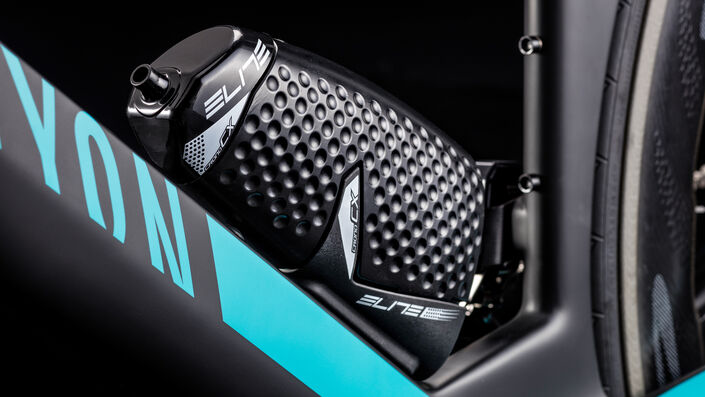
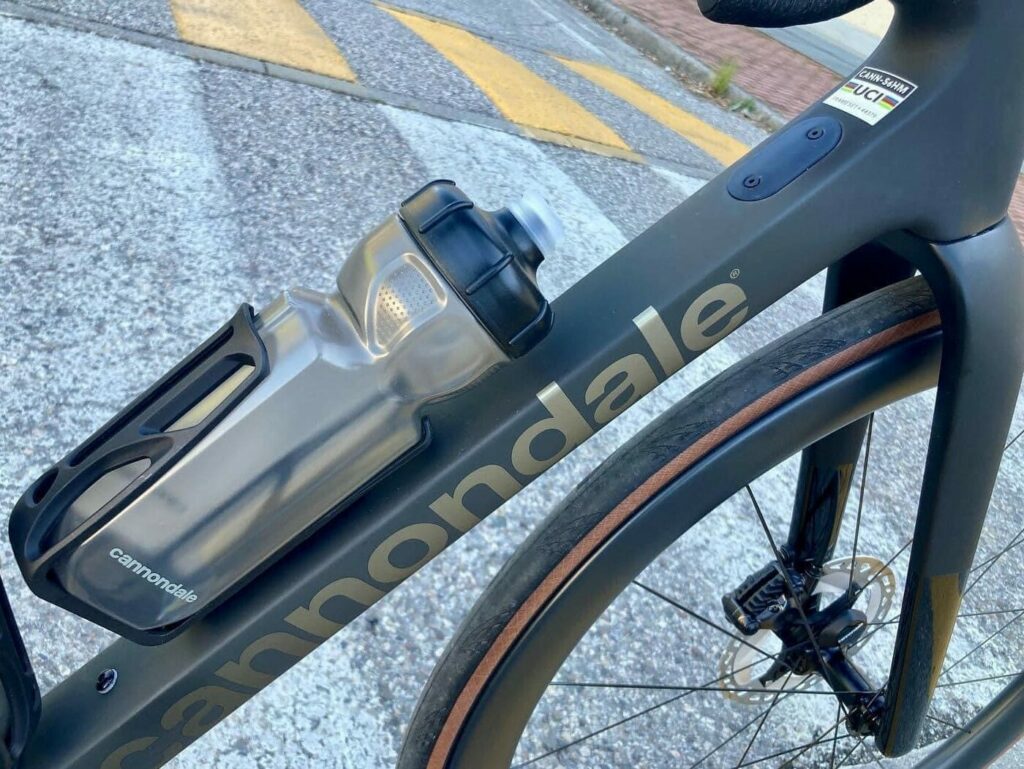
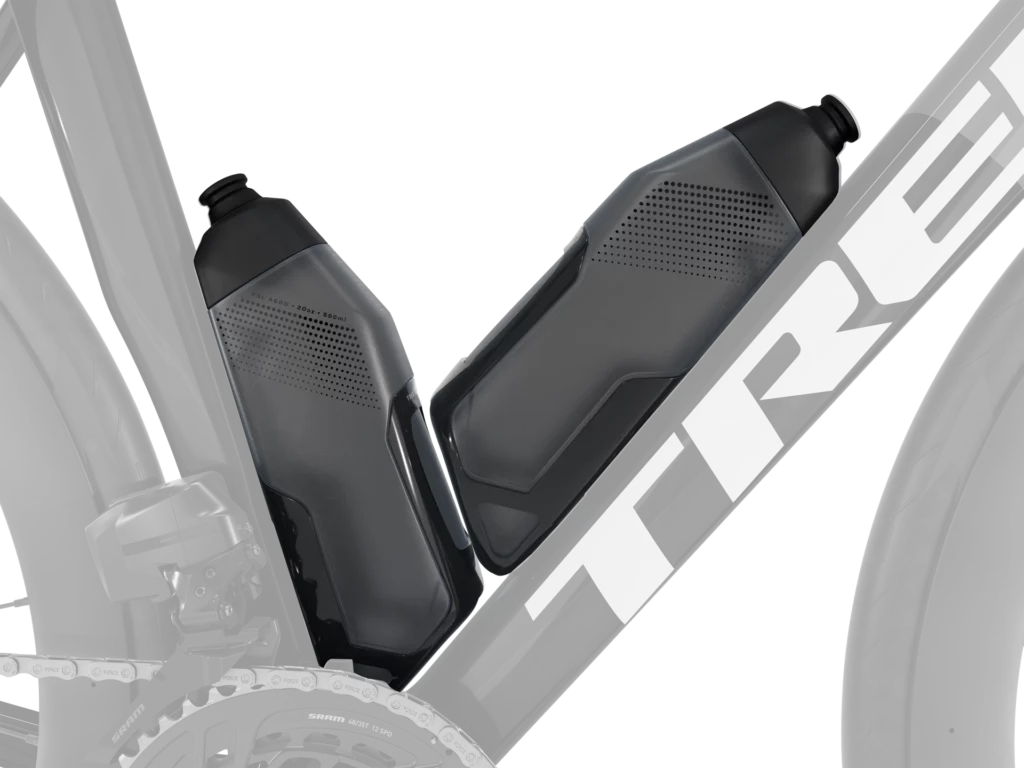
Race day tips to go fastest with bike bottles
As amateur cyclists, we rarely have the advantage of teammates or support vehicles to provide us with a constant supply of cold drinks. Therefore, managing our fluid intake becomes crucial to our performance, especially during Grand Fondos. Access to hydration can be limited, and feed stations may not always be well-organized, making it even more critical for us to plan ahead and bring enough fluids to keep ourselves hydrated during the ride.
Choose rather 2 smaller bike bottles than a big one
Generally, use 2 small bottles at 550 ml rather than one big one. They sit more stable and add flexibility. This setup is also potentially more advantageous from an aerodynamic point of view, but, as always, without testing, it is hard to say. You may want to opt for bigger bottles for longer events without support, especially if you consider using one bottle with only water as a shower and cooling option.
Start your race with a bottle in the jersey pocket
If you want to limit your stops at feed stations, bringing enough food is usually not the challenge, but liquid is, especially on a hot day. One strategy is to start with 3 bottles and have one as a throw-away. You race the beginning with an additional bike bottle in the jersey, dispose of one at the first feed and just go on. This can be especially useful if the first feed is at a critical place where you want to stay in a fast group and not stop.
Pro tip: Stash an extra water bottle for the Grand Fondo in your jersey. Dispose of it (no littering!) before the first big climb to ensure you have enough fluids for the whole ride. It’s an excellent way to cut down on stops, especially when it’s hot.
Moreover, you may even benefit from a significant aero benefit if you place it in the middle pocket of your jersey, as Dylan Johnson explains in the following short clip. He saw savings of over 3 watts when testing in the wind tunnel:
Use a water bike bottle to keep you cool
On a hot day, overheating can significantly affect your cycling performance. When the body gets too hot, it starts to limit our capabilities. It’s important to remember that about 75% of all the energy expended while cycling turns into heat, whereas only 25% actually goes into moving the bike forward. To cool yourself during the ride, it’s a smart idea to bring a bottle of water and use it to shower yourself to take advantage of the cooling effect of evaporation. Keeping your head and face cool is crucial to maintaining your body’s performance. Additionally, cooling down your back and crotch area, where the prominent veins are located, can be very effective.
Over 75% of the energy you expend while cycling is turned into heat, which your body needs to eliminate. Once you start overheating, your body automatically limits performance. Therefore, prioritize staying cool, especially before you get too hot!
Particularly before getting to the challenging section of a route, such as a deciding climb, it can be an excellent idea to prioritize your cooling while you are maybe still cruising in the pack. If you start with a body temperature just a half degree lower than your competitors, you can work that little longer on that climb. Give it a try! You might be surprised at how effective it is. Remember, prioritizing your body’s performance is always more important than worrying about carrying a few extra grams.
Many Grand Fondos start with a climb to separate the field. It may be obvious, but you can have an empty bottle on your bike and fill it up later at the feed. Another minor, marginal gain.
Make sure your bottle cage firmly secures the bike bottle
Bike bottles generally have a standard shape, so bottle cages should be compatible with all types of bike bottles. However, in reality, some combinations work better than others. Losing a bike bottle can be quite frustrating and significantly slow you down. In many race situations, it may be impossible to retrieve a lost bottle. Therefore, it’s important to ensure that the bottle and its holder work well together.

From the picture above, it’s noticeable that even grip tape is used in the pro peloton. However, this can significantly reduce the lifespan of your bottle. Pairing the bottle with a holder from the same manufacturer ensures best compatibility. For example, the Elite T-Race Carbon, a super, lightweight bottle cage, works well with Elite Fly bottles, but not so with most others.
You will find many different shapes and styles of bottle cages on the market, which only differ in design and weight difference, which is probably not very relevant. Similarly, whether the material is plastic or carbon may not matter all that much. Just carbon may look and feel a little higher quality and match your carbon frame.
Dispose of your bottle before the final sprint
As mentioned earlier, using round, non-aero bottles can increase the drag by 7-8 watts when cycling at a speed of 45 km/h. During the final phase of a race, especially during a sprint, the speed is likely even higher, increasing the penalty to 10 watts or more. Therefore, it is worthwhile to dispose of your bottles before the final lap of the crit or any other flat stage. At those higher speeds, they can greatly impact your performance.
 Made me Slower
Made me Slower
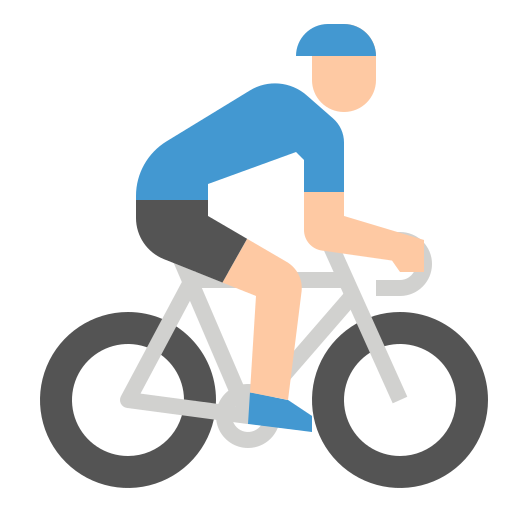 Same, Same
Same, Same
 Made me Faster
Made me Faster

